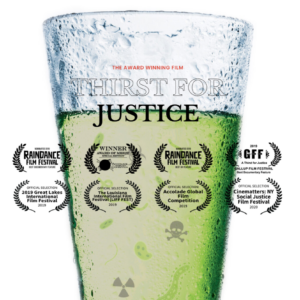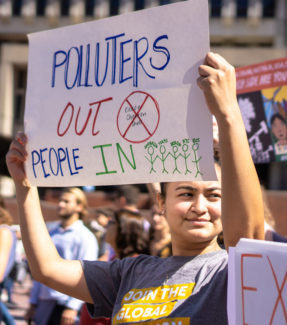The following guest post is authored by BBC investigative journalist Leana Hosea, Director of ‘Thirst For Justice’ a new documentary film that connects the struggle for clean water in Flint and Standing Rock, through the women fighting for justice.
“They say wash your hands to protect yourself, but the nearest water source is 25 miles away,” laments 60-year-old Navajo sheepherder, Mary Lane. Some 40% of Navajos don’t have running water and the outbreak of coronavirus has brought that lack of water infrastructure into deadly relief.
Across the country, indigenous Americans have the highest actual COVID-19 mortality rates and are dying at more than twice the rate of their white counterparts, according to the Centers for Disease Control (CDC). Moreover, the lack of indoor plumbing and access to potable water was found to be the most important determinant of the increase in Covid-19 cases, in a research study for the Journal of Public Health Management and Practice. Much more so than overcrowded living conditions or language barriers.
“The distance people have to go to fetch water has been getting further. Water overuse from mining and drought mean many wells are tapped out,” says Janene Yazzie, a Navajo community activist. “We don’t even know if the water is clean,” says Ms. Yazzie. Almost 25 percent of the most toxic waste sites are on Indian lands and the Navajo Nation is a prime example of this.
Traversing the Navajo Nation while making my documentary, ‘Thirst For Justice’, about water contamination and environmental justice, I visited numerous communities living amidst piles of uranium mine waste. Some were so radioactive the Geiger counter maxed out.
“The readings you found are much higher than those around Chernobyl that have been evacuated for the long term,” said Kim Kearfott, professor of Nuclear Engineering and Radiological Sciences at the University of Michigan.
Many drinking water sources on the Navajo Nation have been contaminated with uranium and arsenic, which can cause kidney disease, cancers, high blood pressure, and autoimmune diseases, such as rheumatoid arthritis. All are underlying health problems that make death from coronavirus more likely.
African Americans are not faring much better. Nationwide, Black Americans have experienced 14.9% of all deaths of known race, but represent 12.4% of the population, according to AMP Research. Similarly, there’s a lack of access to potable water among this population.
“The water would come out looking like chicken broth or dark liquor,” says Flint organizer Nayyirah Shariff. “Sometimes it would smell like poop or super chloriney.” The problem of toxic lead leaching into America’s tap water from pipe infrastructure came to the fore with the Flint water crisis. But a 2019 report from Environment America, showed elevated lead levels in the water systems of schools across the country. The CDC estimates that about half-a-million children between the ages of 1 and 5 living in the U.S. have an elevated level of lead in their blood. Black American children are three times more likely than white children to have elevated blood lead levels.
Though Flint residents are resilient, many feel worn down and forgotten. Mistrust is so high that some residents still fear drinking the tap water, despite a large pipe replacement program. “The lead pipes in people’s homes have not been replaced”, explains Melissa Mays.
“We don’t want to risk drinking even low levels of lead now, as we’ve drank contaminated water for so long and it accumulates in your bones and organs,” explains another Flint mum, Christina Murphy. Cristina had her newborn baby’s cord blood tested for lead and then had him tested again a year later. “His lead levels went from a 2 to a 3 and I just breastfed him. I’ve literally been poisoning my own son,” exclaims Christina.
According to the CDC, women who have been or are currently exposed to lead can expose their fetus or infant to the toxic metal during pregnancy and breastfeeding, which can have long-term effects on the neurodevelopment of their child. The Navajo Birth Cohort Study on the Navajo Nation showed that uranium also passes from the mother to the fetus.
“When you’re exposed to chemicals or heavy metals via what we eat, or the air we breathe, or the water that we drink, then they can affect our biology,” says Professor Dana Dolinoy, the NSF international Chair of Environmental Sciences at the Michigan School of Public Health. “If you’re pregnant or a male who goes on to become a dad, those cells can be transmitted to the next generation and potentially to the following generations.”
If President Biden is to deliver on his promise to put environmental justice at the heart of his administration’s climate and infrastructure policies, equitable access to clean, safe, and affordable water is key.” Democratic lawmakers and advocates are urging President Biden to back the Water Affordability Transparency Equity and Reliability (WATER) Act, proposing unprecedented investment in America’s ailing water infrastructure, provide assistance to indigenous communities and address contamination. As my film ‘Thirst For Justice’ shows, help on all these fronts is desperately needed.
‘Thirst For Justice’ premieres on Bloomberg Quicktake Streaming TV March 6th 21:00ET https://www.bloomberg.com/qt/live
Trailer: https://vimeo.com/514272869
For information on more screening times and ways to watch the film please check https://www.facebook.com/ThirstForJusticeDocumentary or contact [email protected]




